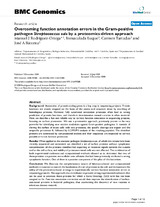Mostrar el registro sencillo del ítem
Overcoming function annotation errors in the Gram-positive pathogen Streptococcus suis by a proteomics-driven approach
| dc.contributor.author | Rodríguez-Ortega, Manuel J. | |
| dc.contributor.author | Luque-Moreno, Inmaculada | |
| dc.contributor.author | Tarradas-Iglesias, Carmen | |
| dc.contributor.author | Bárcena Ruiz, José Antonio | |
| dc.date.accessioned | 2014-02-17T12:00:14Z | |
| dc.date.available | 2014-02-17T12:00:14Z | |
| dc.date.issued | 2008 | |
| dc.identifier.uri | http://hdl.handle.net/10396/11701 | |
| dc.description.abstract | Background: Annotation of protein-coding genes is a key step in sequencing projects. Protein functions are mainly assigned on the basis of the amino acid sequence alone by searching of homologous proteins. However, fully automated annotation processes often lead to wrong prediction of protein functions, and therefore time-intensive manual curation is often essential. Here we describe a fast and reliable way to correct function annotation in sequencing projects, focusing on surface proteomes. We use a proteomics approach, previously proven to be very powerful for identifying new vaccine candidates against Gram-positive pathogens. It consists of shaving the surface of intact cells with two proteases, the specific cleavage-site trypsin and the unspecific proteinase K, followed by LC/MS/MS analysis of the resulting peptides. The identified proteins are contrasted by computational analysis and their sequences are inspected to correct possible errors in function prediction. Results: When applied to the zoonotic pathogen Streptococcus suis, of which two strains have been recently sequenced and annotated, we identified a set of surface proteins without cytoplasmic contamination: all the proteins identified had exporting or retention signals towards the outside and/or the cell surface, and viability of protease-treated cells was not affected. The combination of both experimental evidences and computational methods allowed us to determine that two of these proteins are putative extracellular new adhesins that had been previously attributed a wrong cytoplasmic function. One of them is a putative component of the pilus of this bacterium. Conclusion: We illustrate the complementary nature of laboratory-based and computational methods to examine in concert the localization of a set of proteins in the cell, and demonstrate the utility of this proteomics-based strategy to experimentally correct function annotation errors in sequencing projects. This approach also contributes to provide strong experimental evidences that can be used to annotate those proteins for which a Gene Ontology (GO) term has not been assigned so far. Function annotation correction would then improve the identification of surfaceassociated proteins in bacterial pathogens, thus accelerating the discovery of new vaccines in infectious disease research. | es_ES |
| dc.format.mimetype | application/pdf | es_ES |
| dc.language.iso | eng | es_ES |
| dc.publisher | BioMed Central | es_ES |
| dc.rights | https://creativecommons.org/licenses/by-nc-nd/4.0/ | es_ES |
| dc.source | BMC Genomics 9: 588 (2008) | es_ES |
| dc.subject | Streptococcus suis | es_ES |
| dc.subject | Proteomics-driven | es_ES |
| dc.title | Overcoming function annotation errors in the Gram-positive pathogen Streptococcus suis by a proteomics-driven approach | es_ES |
| dc.type | info:eu-repo/semantics/article | es_ES |
| dc.rights.accessRights | info:eu-repo/semantics/openAccess | es_ES |

